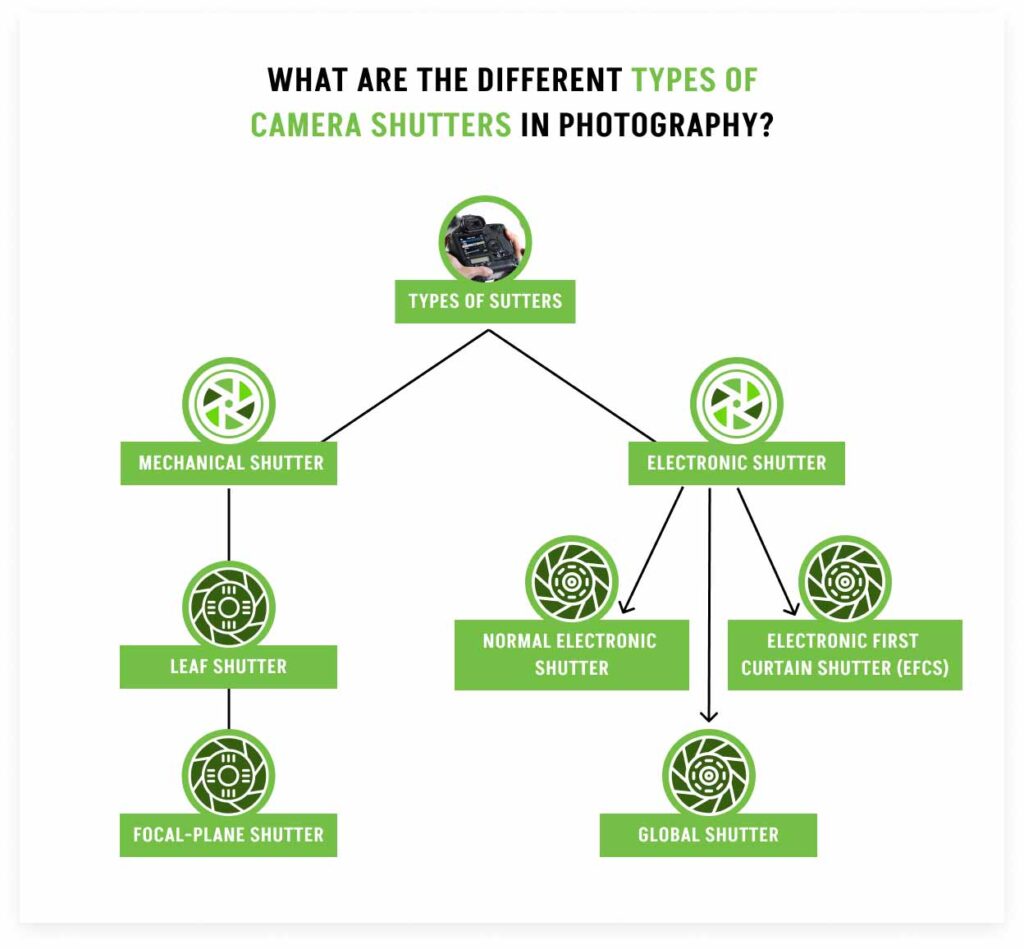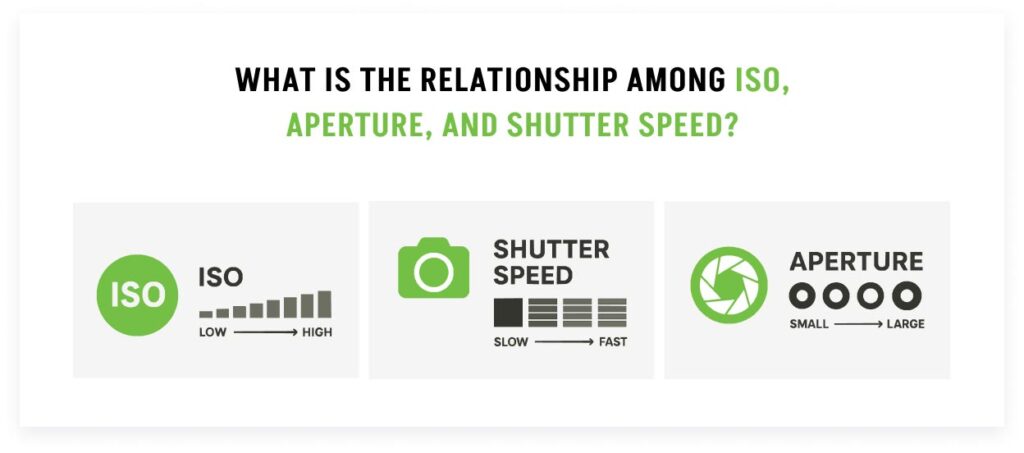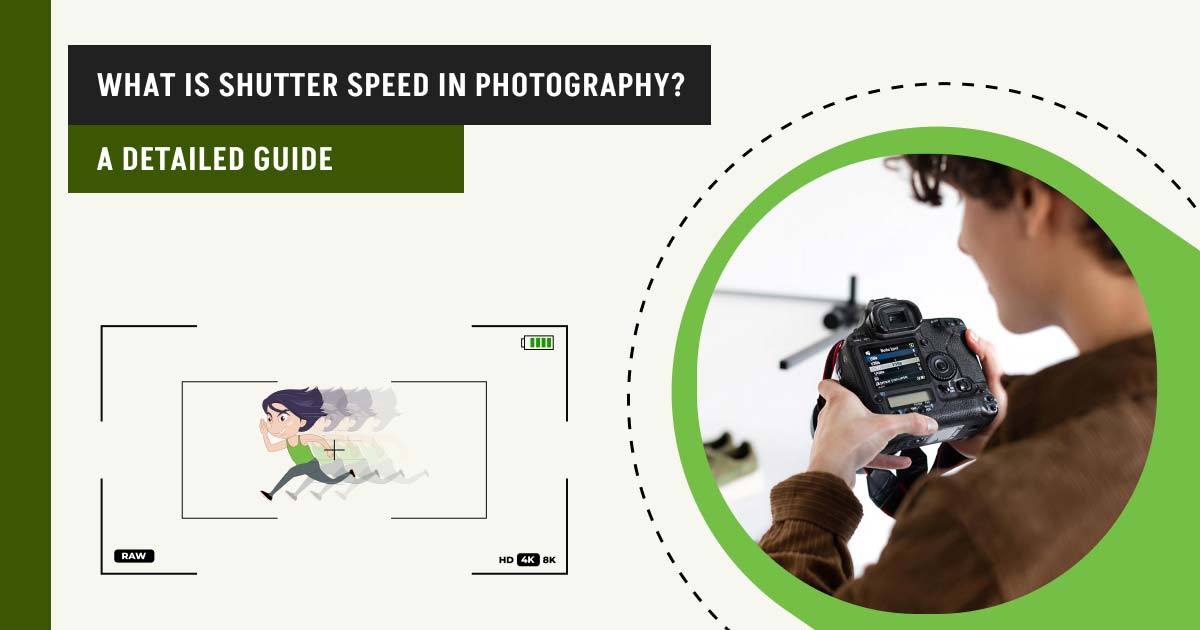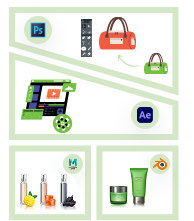Shutter speed refers to the duration a camera’s sensor remains open to capture light. It is located in the viewfinder, on top of the LCD panel, or in the rear screen of a camera. The role of shutter speed in photography is to control exposure and motion.
There are mainly 2 types of shutters in a camera, electronic shutters and mechanical shutters. Electronic shutters automatically turn on and off to control exposure, and mechanical shutters capture images with 2 physical blades.
Shutter speeds appear fast, slow, and long depending on the time duration the sensor is exposed to light to capture the image. A faster shutter speed exposes the sensor for a short time and freezes motion. A slower shutter speed allows more time for the light to enter the camera. A long shutter speed takes a longer time than a slow shutter speed and is used for the creative use of motion blur in photography.
What you’ll learn in this article
- 1 What is Shutter Speed in Photography?
- 2 What is the Purpose of Shutter Speed in Photography?
- 3 What are the Different Types of Camera Shutters in Photography?
- 4 How Do You Set Camera Shutter Speed?
- 5 How Do You Measure Shutter Speed in Photography?
- 6 How Do Fast, Slow, and Long Shutter Speeds Differ?
- 7 FAQs about Shutter Speed on a Camera
What is Shutter Speed in Photography?
Shutter Speed is the time range a camera’s shutter stays open to capture an image, while exposing its sensor to the light and controlling the brightness and motion. This sensor’s exposure time to light controls the amount of light in images, resulting in the brightness or darkness level and motion.
Professional photographers take photos in fast, slow, and long shutter speeds. A fast shutter speed results in dark images and reduces motion blur, but it freezes motion which is effective for capturing action or movement. Slow shutter speed results in bright images but introduces motion blur. Long shutter speed brightens images and creates a pronounced motion blur.
Where is the Shutter Speed on a Camera?
The shutter speed on a camera is located at the viewfinder, on the top of the LCD panel, or in the rear screen, depending on the camera as follows.
| Camera Type | Shutter Speed Position in Camera |
|---|---|
| DSLR cameras | Set the mode dial to M or S/Tv. A command dial to adjust shutter speed will appear on the top of the LCD, rear LCD, or in the viewfinder. |
| Mirrorless cameras | Set the mode dial to M or S/Tv. A command dial to adjust shutter speed will be visible on the rear LCD or in the electronic viewfinder. |
| Medium format cameras | Offers a dedicated dial or has a similar system to modern DSLR or mirrorless cameras. |
What is the Difference Between Shutter Speed Vs. Shutter Angle?
The key difference between shutter speed vs. shutter angle is the measurement method; shutter speed is measured in time in photography, whereas shutter angle is measured in degrees or rotation in videography. Other differences between shutter angle and shutter speed are as follows.
| Parameters | Shutter Speed | Shutter Angle |
|---|---|---|
| Identity | A result of measuring the time duration of sensor exposure to light in photography. | An input of value in degrees to achieve a specific look in cinematography. |
| Measurement | Fractions of seconds or seconds | Rotation or degrees (1∘ to 360∘) |
| Relation | Independent of frame rate | Proportional to the frame rate |
| Purpose | To control exposure and motion blur | To maintain motion blur |
| Use cases | Still Photography | Videography, cinematography |
What is the Purpose of Shutter Speed in Photography?
The key purpose of shutter speed in photography is to control exposure and motion. It determines the time duration for the sensor to be exposed to light. A fast shutter speed allows minimum exposure, making images dark, but it freezes motion for sharp images. A slow shutter speed allows maximum exposure, making images bright, and introduces creative motion blur.
What are the Different Types of Camera Shutters in Photography?
There are 2 types of camera shutters in photography,
- Mechanical shutter and
- Electronic Shutter
This diagram illustrates the different types of camera shutters in photography.

1. Mechanical Shutter
Mechanical shutter is the physical blades or curtains made of metal plates located in front of the sensor. There are 2 metal plates that click with each other in the camera’s sensor. The mechanical shutter makes a ‘click’ sound to notify activation, opens one curtain to expose the sensor to light for a set time, and the second curtain closes it.
The disadvantage of mechanical curtains is the risk of shutter shock (vibration from curtains moving) and a slower maximum shooting speed. The mechanical shutter is the traditional shutter found in all DSLRs and mirrorless cameras. Mechanical shutters are divided into 2 main categories based on their build and location:
- Leaf Shutter
The lens shutter is a shutter made of several thin metal blades inside the lens, near the aperture. It exposes the entire frame as the blades swiftly open from the center and close back when the exposure ends.
Though a leaf shutter is not convenient for interchangeable lens systems, the benefit of a leaf shutter is to synchronize with a flash at any shutter speed, which is why it is mostly used in portrait photography and studio photography. Medium format cameras mostly have a leaf shutter incorporated.
- Focal-Plane Shutter
Focal-plane shutter is the shutter consisting of 2-set of curtains in front of the camera’s sensor. Exposure begins by opening the first curtain and ends when the second curtain follows. When a faster shutter speed is applied, those curtains quickly pass the sensor together, creating a small slit of light to expose the image. It often creates limited flash sync speed, but this shutter is able to achieve faster maximum shutter speeds such as 1/4000s or 1/8000s, highly effective for taking action shots. Mirrorless cameras and modern DSLRs have this technology implemented.
2. Electronic Shutter
The electronic shutter is the camera sensor being turned on and off electronically, offering faster shutter speeds. It reads image data sequentially, different from the mechanical shutter (which exposes the entire sensor to the light at once). This eliminates noise and micro-vibrations generated by the mechanical clicking of a mechanical shutter, resulting in a clearer image.
The downsides of the electronic shutter are the rolling shutter effect from fast movements and banding from flickering lights. The electronic shutter is a modern shutter and is available in most modern mirrorless cameras. Electronic shutter is categorized into 3 types: normal electronic shutter, global shutter, and electronic first curtain shutter.
- Normal Electronic Shutter
A normal electronic shutter reads image data from top to bottom and line by line. It can cause distortion and banding effects (under artificial illumination). Having no moving parts, it has a silent mechanism and achieves faster shutter speeds.
- Global Shutter
A global shutter is a shutter that addresses the rolling shutter issues. This advanced type of shutter reads image data from the entire sensor during exposure. Since all the pixels get captured at the same time, it creates a whole image within a single moment. It captures action shots or fast camera movement images with accurate sharpness and removes banding issues. The downside of global shutters is price and limitation in dynamic range.
- Electronic First Curtain Shutter (EFCS)
EFCS is a hybrid type of shutter that combines the mechanisms of both electronic and mechanical shutters. Due to its merging with modern shutter technology, this hybrid shutter falls into the electronic shutter category. The exposure begins with an electronic shutter, and a physical mechanical blade ends it. It doesn’t have any click or vibration of the mechanical shutter, though, and is quieter than a mechanical shutter. Many mirrorless cameras and advanced-level DSLRs have this feature.
What is the Difference Between an Electronic Shutter and a Mechanical Shutter?
The difference between an electronic shutter and a mechanical shutter is the method of exposing the camera’s sensor to light. Mechanical shutter uses 2 physical blades to expose the camera’s image sensor to light; the first curtain opens to begin the exposure, and the 2nd curtain closes the exposure. The electronic shutter automatically controls the camera’s image sensor’s exposure at the set time.
Other differences between the electronic shutter and mechanical shutter are as follows.
| Criteria | Electronic Shutter | Mechanical Shutter |
|---|---|---|
| Shutter Method | Modern Method | Traditional Method |
| Function | Uses the sensor’s ability to control exposure electronically without any moving parts. | Uses physical curtains/blades to control sensor exposure to light for a specific time. |
| Speed | Faster than mechanical in terms of continuous shooting and maximum speed. | Slower than electronic, and limited by the speed of moving parts. |
| Noise | Noiseless | Creates a ‘click’ sound |
| Vibration | Produces no vibration | Produces micro-vibration |
| Benefits | High continuous shooting speeds and faster shutter speeds. | Better dynamic range and less susceptible to banding issues during shooting in artificial light. |
| Camera | Modern mirrorless cameras and advanced DSLRs. | Mirrorless and DSLR cameras |
How Do You Set Camera Shutter Speed?
You can set the camera shutter speed by using shutter priority mode, manual mode, or auto mode. When you set the shutter speed, the priority mode (Tv or S) automatically adjusts the aperture, aligning with the surroundings. The manual mode lets you completely control the exposure. Activating the auto mode makes the camera automatically set the shutter speed. The key difference between priority mode and auto mode in terms of shutter speed is who controls the setting. In the priority mode, the photographer manually sets it. In the auto mode, the camera automatically selects it.
1. Shutter Priority Mode
Shutter Speed Priority mode, also called shutter priority mode, is a partial-auto camera setting that selects the ISO and aperture based on the shutter speed you select. It is labeled as ‘S’, ‘Tv’, or ‘time value’ on digital camera mode dials and works great under proper lighting, ensuring a balanced exposure, controlling motion blur, and freezing fast actions. Nikon and Sony use an “S” symbol for this mode, while Canon and Pentax use a “TV” symbol. Camera brands mention it in the camera’s manual.
Instruction: To enable priority mode in shutter speed, rotate the mode selector (a circular dial on the top left or right of the camera’s body) to shutter priority (S or Tv) mode and select the shutter speed using the camera’s selector buttons.
2. Manual Mode
Manual mode refers to the manual process of adjusting the exposure triangle: shutter speed, aperture, and ISO. This mode is the best to learn about exposure. Professional photographers mostly use manual mode to create highly customized settings for a picture-perfect image, for example, e-commerce product photography camera settings.
Instruction: Manual mode is symbolized by ‘M’ in the camera. To enable manual mode, rotate the mode selector (a circular dial on the top left or right of the camera’s body) to Manual (M) mode. Select the shutter speed, aperture, and ISO using the camera’s selector buttons.
3. Auto Mode
Auto mode is when the camera decides the settings to take a shot on behalf of the photographer. It works great capturing photos in changing environments or moving objects, such as model photography camera settings, or car photography camera settings. As those scenarios involve movements and actions, frequent adjustment of exposure settings is necessary.
Instruction: To enable auto mode, rotate the mode selector (a circular dial on the top left or right of the camera’s body) to auto (Auto or A+) mode.
How Do You Measure Shutter Speed in Photography?
You can measure/read the shutter speed in photography by the numbers or fractions that appear on the LCD screen or the viewfinder. Those numbers or fractions indicate time. A value of 1/2000 indicates a faster shutter speed, while 1″ (one second) means a slower shutter speed.
When in a fraction, the larger the denominator, the less the sensor exposure to light and the faster the shutter speed. Conversely, a small denominator means more sensor exposure to light and a slow shutter speed.
The subject’s position mostly impacts shutter speed measurements. Still objects are captured with a slower shutter speed, and moving/action objects are captured with a faster shutter speed. Still objects, such as camera settings for footwear, aim to capture sharp images without blur. Shutter speed such as 1/125, 1/60, or even slower would suffice. Slower shutter speed allows more light to the camera sensor, creating well-lit photos. Moving objects, such as a car, require faster shutter speeds to freeze motion in photography. Use a slower shutter speed to add a sense of speed by introducing motion blur in the images.
Shutter speed measurement and its impact on images in different conditions are listed here in a chart below.
| Shutter Speed in Camera | Time denoted in Seconds | Object Appearance | |
|---|---|---|---|
| Still | Motion | ||
| 10″ | 10s | Appears sharp (in tripod) | Creates Motion Blur |
| 1″ | 1s | Appears sharp (in tripod) | Creates Motion Blur |
| 1/125 | 0.008s | Appears sharp (in handheld) | Creates slight motion blurs on Faster movements. |
| 1/2000 | 0.0005s | Appears sharp | Freezes motion to capture sharp images. |
How Do Fast, Slow, and Long Shutter Speeds Differ?
Fast, slow, and long shutter speeds differ based on the time duration a sensor is exposed to light and its effect on the final image. A fast shutter speed keeps the sensor open for the shortest time and is used for freezing motion. A slow and long shutter speed allows more light to enter the sensor and creates motion blur or illuminates the photo.
Other differences among fast shutter speed, slow shutter speed, and long shutter speed are as follows.
| Criteria | Fast Shutter Speed | Slow Shutter Speed | Long Shutter Speed |
|---|---|---|---|
| Lighting effects | Allows less light to reach the sensor | Allows more light to enter the sensor | Allows ample time for light to get to the sensor. |
| Duration | A short amount of time, such as 1/1500th of a second or faster | A longer amount of time, for example, 1/30th of a second to a few seconds | An extremely long amount of time can take up to a minute. |
| Purpose | To freeze motion | To create motion blur | To create creative effects and capture motion blur. |
| Usecases | Action shots, handheld photography, and sports photography | Panning shots and low-light photography | Astrophotography and night photography. |
What is the Best Shutter Speed for Portraits?
The best shutter speed for a portrait is 1/15 or higher when using a tripod. And 1/60 or above while shooting handheld, or if your models are kids. Portrait models, being people, don’t need much fast shutter speed, but the kids do, as they tend to be impatient.
While capturing portrait models in photography, use the golden equation or reciprocal rule for handheld photography, which is: shutter speed = 1 / focal length of lens. It means, if you have a 54mm camera lens, use a shutter speed of 1/54 or higher (1/60, 1/100).
What is the Best Shutter Speed for Low Light?
The best shutter speed for low-light situations is to use a slower shutter speed to allow more light to enter the sensor. The best shutter speed changes based on the subject and surroundings- a long shutter speed for still subjects, or a faster shutter speed for freezing moving subjects. Increase the ISO and aperture settings to balance the right frame.
Note: The best camera settings for night photography or low-light photography are a wide aperture, high ISO, and a long shutter speed.
What is the Relationship Among ISO, Aperture, and Shutter Speed?
The relationship among ISO, aperture, and shutter speed is known as the exposure triangle. They are interdependent and changing one settings require changing another or all of them to maintain the same level of brightness. They contribute to the level of lightness and darkness, the appearance of motion blur, and the depth of the field in images. The image shows the relationship among ISO, aperture, and shutter speed.

What is the Relationship Between ISO and Shutter Speed?
The relationship between ISO and shutter speed is opposite. While shutter speed determines the duration of the camera’s sensor exposure to light, ISO controls its sensitivity to light.
Higher ISO makes the sensor more sensitive, which requires less light for the right exposure. A faster shutter speed would complement that high sensitivity by shortening the duration sensor’s exposure to light, providing less light to capture images, along with freezing motion. On the contrary, low ISO makes images less sensitive to light, which demands more light for proper exposure in images. By using a slow or long shutter speed, you allow more light.
In short, for the right exposureHigher ISO requires less light=Complemented by faster shutter speed. Low ISO requires more light=Complemented by a slow/long shutter speed.
*High ISO creates digital noise or grain effects in images. That’s why starting from a low ISO is recommended.
Example: To shoot action or motion, for example, sports photography, increase ISO and use a faster shutter speed to avoid blur, freeze motion, and achieve sharp and well-exposed images. While shooting landscape photography, start shooting from a low ISO and slow shutter speed for proper exposure and a smooth effect of natural elements.
What is the Relation Between Aperture and Shutter Speed?
The relation between aperture and shutter speed is inverse. Shutter speed controls the duration of light in the camera sensor, and aperture controls the amount of light entering the camera lens.
A wide aperture (defined by a smaller number, such as f/2.8) allows more light. To compensate for this higher light, a faster shutter speed is required. A narrow aperture (defined by a large number, such as f/11) allows less light, which requires a slow shutter speed for the right exposure.
A wide aperture requires a fast shutter speed. Narrow aperture requires a slow/long shutter speed.
Example: While taking portrait photography, set a wide aperture for portraits and a faster shutter speed for well-exposed and sharp images with a beautiful, blurry background. Set a narrow aperture and slower shutter speed to shoot product photography for both the foreground and background appear sharp, and well-exposed photos.
What is the Relationship Between ISO and Aperture?
The relation between ISO and aperture is the opposite of each other. Aperture controls the amount of light inside the lens, and ISO controls the sensor’s sensitivity to light.
Higher ISO makes the sensor more sensitive to light, and a narrow aperture (defined by large numbers such as f/11, f/16, etc) compensates for it. Lower ISO makes the sensor less sensitive and needs more light, which a wide aperture (defined by small numbers such as f/2.8) can adjust.
FAQs about Shutter Speed on a Camera
What is the 180-degree shutter rule?
The 180-degree shutter rule is a cinematography rule stating the camera’s shutter speed should be set to a value that is one over double the frame rate. For example, the ideal shutter speed for a video frame rate of 24 frames per second (FPS) should be 1/48 of a second. Setting the shutter speed slower than the rule will create excess motion blur, and a faster speed will create little motion blur.
What is the shutter speed for people walking?
The shutter speed for people walking is 1/300, which is sufficient to freeze human walking. For faster movements, such as running, 1/500 would be good. This speed would make their actions static and allow you to achieve sharp images under the right exposure.
What shutter speed do eyes see?
Human eyes can see shutter speed as short as 1/100 of a second under flickering lights or flashes and 1/200 of a second under controlled lighting conditions. The human eye doesn’t view images the same way a camera does. While a camera processes images in a set time, the human eye and brain process images by consuming different information.
What is a rolling shutter effect?
The rolling shutter effect is a digital artifact that occurs when the camera’s sensor reads images line by line, creating distorted views due to the subject’s fast motion. The sensor fails to capture complete images due to the time differences. It creates several distortions such as skewing, wobbling effects, curved or bent view, etc, which are a primary downside of the normal electronic shutter.
What is the minimum shutter speed to avoid blurry shooting?
The minimum shutter speed to avoid blurry shooting is known as the reciprocal rule, which is “shutter speed should be at least one over your lens’s focal length.”
The safe shutter speed for a 50mm lens would be 1/50th of a second, and for a 24mm wide-angle lens, it would be 1/25th of a second. Longer focal lengths magnify both the subject and the shakes, making the blurs obvious. Image stabilization technology is used to address this camera issue.
Which cameras have the fastest shutter speed?
Nikon D5, Canon EOS 7D Mark II, Fuji X-T2, Panasonic GH5, Samsung NX1, and Olympus OM-D E-M5 Mark II cameras have the Fastest Shutter Speed. Reputed camera brands such as Nikon, Canon, and Panasonic offer the highest shutter speed of 1/8000 seconds.

